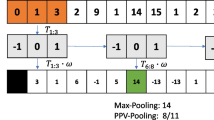Abstract
Weather forecasts often affect daily lives of billions of people globally. Accurate forecasts can help combat and effectively mitigate damage caused by extreme weather. Alternatively, faulty forecasts can consequently lead to unnecessary financial investments and a waste of resources. Our work explores what is the extent of variability in errors of the National Weather Service predictions as observed in 113 cities in the United States between July 1, 2014 and September 1, 2017 and attempts to model the distribution of errors. Simultaneously, we deliver an interactive tool for future researchers to explore the actual and forecast weather data as well as expose hidden patterns in the data.















Similar content being viewed by others
Notes
JSM-2018-Weather-App: https://github.com/JiananH/JSM-2018-Weather-App.
References
Akaike H (1973) Information theory and an extension of the maximum likelihood principle. In: Petrov BN, Csaki BF (eds) Second international symposium on information theory. Academiai Kiado, Budapest
Box G, Jenkins G, Reinsel G (1970) Time series analysis: forecast and control. Wiley, Hoboken
Chang W, Cheng J, Xie Y, Mcpherson JEA (2019)Shiny v1.4.0: web application framework for R. R package version 3.0.2 and up
Cox D (1969) Analysis of binary data. Chapman and Hall, London
Farrand J (1990) Weather. Stewart, Tabori & Chang, New York
Farrand J (1991) From gods to satellites. Weatherwise 44:30–36
Hyndman RJ (2006) Another look at forecast-accuracy metrics for intermittent demand. Foresight 4:43–46
Lorenz EU (1972) Predictability: Does the flap of a butterfly’s wings in brazil set off a tornado in texas? Paper delivered at the American Association for the Advancement of Science, Washington
Author information
Authors and Affiliations
Corresponding author
Additional information
Publisher's Note
Springer Nature remains neutral with regard to jurisdictional claims in published maps and institutional affiliations.
Rights and permissions
Springer Nature or its licensor (e.g. a society or other partner) holds exclusive rights to this article under a publishing agreement with the author(s) or other rightsholder(s); author self-archiving of the accepted manuscript version of this article is solely governed by the terms of such publishing agreement and applicable law.
About this article
Cite this article
Roy, D., Vaughan, G., Hui, J. et al. An exploration of National Weather Service daily forecasts using R Shiny. Comput Stat 38, 1173–1191 (2023). https://doi.org/10.1007/s00180-023-01341-9
Received:
Accepted:
Published:
Issue Date:
DOI: https://doi.org/10.1007/s00180-023-01341-9




